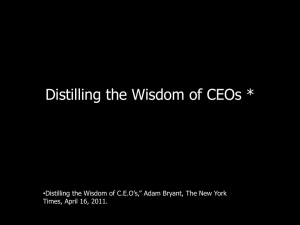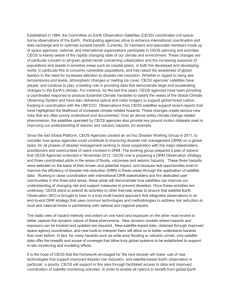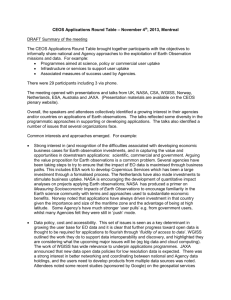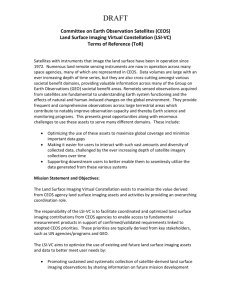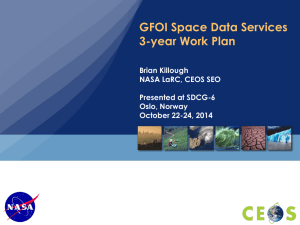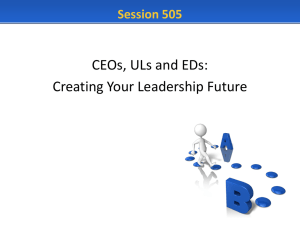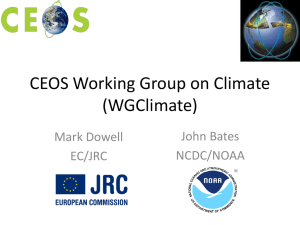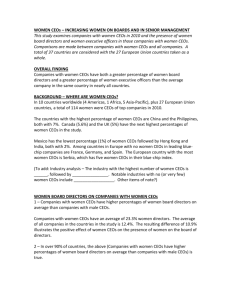Document
advertisement
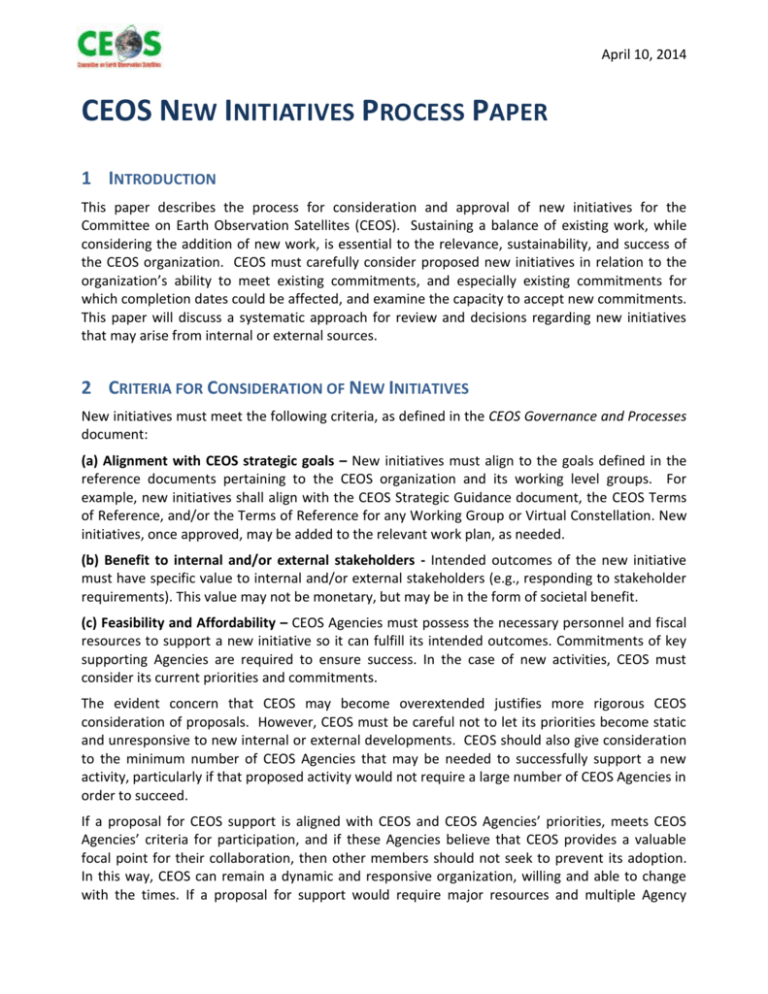
April 10, 2014 CEOS NEW INITIATIVES PROCESS PAPER 1 INTRODUCTION This paper describes the process for consideration and approval of new initiatives for the Committee on Earth Observation Satellites (CEOS). Sustaining a balance of existing work, while considering the addition of new work, is essential to the relevance, sustainability, and success of the CEOS organization. CEOS must carefully consider proposed new initiatives in relation to the organization’s ability to meet existing commitments, and especially existing commitments for which completion dates could be affected, and examine the capacity to accept new commitments. This paper will discuss a systematic approach for review and decisions regarding new initiatives that may arise from internal or external sources. 2 CRITERIA FOR CONSIDERATION OF NEW INITIATIVES New initiatives must meet the following criteria, as defined in the CEOS Governance and Processes document: (a) Alignment with CEOS strategic goals – New initiatives must align to the goals defined in the reference documents pertaining to the CEOS organization and its working level groups. For example, new initiatives shall align with the CEOS Strategic Guidance document, the CEOS Terms of Reference, and/or the Terms of Reference for any Working Group or Virtual Constellation. New initiatives, once approved, may be added to the relevant work plan, as needed. (b) Benefit to internal and/or external stakeholders - Intended outcomes of the new initiative must have specific value to internal and/or external stakeholders (e.g., responding to stakeholder requirements). This value may not be monetary, but may be in the form of societal benefit. (c) Feasibility and Affordability – CEOS Agencies must possess the necessary personnel and fiscal resources to support a new initiative so it can fulfill its intended outcomes. Commitments of key supporting Agencies are required to ensure success. In the case of new activities, CEOS must consider its current priorities and commitments. The evident concern that CEOS may become overextended justifies more rigorous CEOS consideration of proposals. However, CEOS must be careful not to let its priorities become static and unresponsive to new internal or external developments. CEOS should also give consideration to the minimum number of CEOS Agencies that may be needed to successfully support a new activity, particularly if that proposed activity would not require a large number of CEOS Agencies in order to succeed. If a proposal for CEOS support is aligned with CEOS and CEOS Agencies’ priorities, meets CEOS Agencies’ criteria for participation, and if these Agencies believe that CEOS provides a valuable focal point for their collaboration, then other members should not seek to prevent its adoption. In this way, CEOS can remain a dynamic and responsive organization, willing and able to change with the times. If a proposal for support would require major resources and multiple Agency commitments in order to succeed, then broader Agency support commensurate with the magnitude of the proposed initiative, and thus a higher threshold for CEOS approval, is required. For a major new initiative, this threshold will require review at two CEOS high-level meetings (e.g., Plenary, SIT). The key to successful proposal review and decision-making lies in a good understanding of required Agency participation and resource commitments, matched against overall CEOS priorities. Increases in scope should not fully occupy CEOS Agencies’ and their resources, and crowd out the ability for CEOS to entertain new ideas and proposals. The following sections of this paper define a process for approval through which CEOS may decide which proposals to accept and which proposals to reject. 3 CEOS SUPPORT TO NEW INITIATIVES Proposals for new initiatives should be considered in terms of the types of support that is requested, and the ongoing relationship that support establishes with stakeholders. Questions such as the following should be considered at the start of every new initiative to understand the extent of support and interaction that may be required: 1. Is the new initiative clearly described with a sufficient level of detail, and in particular, does it contain well-formulated requirements on the CEOS Agencies? 2. What data/information products would CEOS generate in support of this initiative/task? 3. To whom is CEOS Agencies’ data/information being provided? 4. When would products be made available? 5. How would data/information products be transmitted/provided? 6. Which CEOS Agencies are providing remote sensing data/information? 7. When and how is this data/information being provided? 8. What is the feedback from CEOS external users? It should be emphasized that “CEOS support” may come in many shapes and sizes. On the one end of the spectrum, there are major initiatives involving a large number of CEOS Agencies, all supporting a global, resource-intensive, long-term task. These initiatives are often initiated at a high administrative level, and implemented in a “top-down” manner. Examples of these initiatives are the Global Forest Observation Initiative (GFOI) or development of an Essential Climate Variable (ECV) Inventory. On the other end of the spectrum, are smaller-scale projects which involve a smaller number of CEOS Agencies, on shorter-term tasks, involving fewer resources. These actions are often initiated at the Agency-, Working Group-, Virtual Constellation-, or stakeholder-expert level, in more of a “bottom up” manner. Examples of these activities include: development of the Land Surface Imaging moderate resolution optical imaging guidelines, or the Atmospheric Composition Virtual Constellation gap assessment. 2 It is understood that many activities may fall somewhere in the middle, between these two extremes. As such, greater/lesser numbers of CEOS Agencies and resources would need to be considered on a case-by-case basis. But the same analysis of priority and criteria should be applied. Attention must be given to Agency commitments needed to begin a new initiative and to sustain it. Major new initiative proposals that establish a Working Group (WG) or Virtual Constellation (VC) may be required to include plans for leadership succession to ensure continuity. 4 PROCESS FOR APPROVAL OF NEW INITIATIVES The external or internal entity proposing a new initiative should provide a written description of the activity to the CEOS Secretariat (SEC), which will act as a “clearinghouse” for proposals to CEOS (refer to Annexes 1 and 2). This written description should include a brief discussion of the new initiative and address in detail the elements needed to measure success, as defined in section 6 of the CEOS Strategic Guidance document. After analysis of the written description, the CEOS Secretariat will determine the next steps. Each proposed new initiative must be sponsored or led by a CEOS entity. If the entity proposing the initiative is external to CEOS, the Secretariat will suggest a CEOS entity to sponsor the initiative. If the new initiative is proposed by a CEOS entity (e.g., a Working Group-WG, Virtual Constellation-VC, or CEOS Agency), then it is assumed that this CEOS entity will lead the proposed initiative. It is expected that new initiatives proposed to the CEOS Secretariat are significant in nature and require discussion and strategic evaluation by CEOS Principals. Decisions regarding new activities at the working level are made in forums such as WG or VC meetings. If approved, such new initiatives would become part of the CEOS Work Plan (updated annually). In addition, the new initiative may also become part of a WG Work Plan, a VC Work Plan or part of an Ad Hoc Team set of objectives. The CEOS sponsor of a new initiative will prepare a presentation, in addition to the written activity description provided to the Secretariat, which will be sent to decision makers at least two weeks prior to the appropriate decision meeting. The CEOS sponsor will make a brief presentation on the proposed activity during the appropriate decision meeting. If the entity that proposed the new initiative is external to CEOS, that entity is not required to make a presentation, but their presence at the decision meeting should be encouraged, as an opportunity to answer any questions, thus facilitating a full and clear understanding of the proposal. Decisions should be made at appropriate meetings by the decision makers identified in Table 3-1 of the CEOS Governance and Processes document. Additional decision meetings (perhaps teleconferences) may also be arranged to ensure that relevant key decision makers have an opportunity to participate in the decision process. Sufficient time should be reserved on the agenda of the meeting at which the decision will be made to discuss the proposed activity. This discussion should be led by the chair of the decision meeting and the CEOS sponsor and, if applicable, the external entity proposing the new activity. To ensure that sufficient emphasis is placed on decision making, meeting agendas should include a “decision-making session” to discuss all proposed decisions, or clearly highlight the agenda items that are “for decision” rather than “for information.” 3 ANNEX 1: CHECKLIST FOR NEW INITIATIVES FOR CEOS CONSIDERATION 1. Is the proposed activity appropriate for CEOS, rather than for another existing coordination group or private sector organization/association? (Yes/No; if Yes, then continue) 2. Is the proposed activity closely aligned with CEOS priorities, as stated in the CEOS Strategic Guidance Document? (Yes/No; if Yes, then continue) 3. Is the proposed activity well-aligned with a sufficient number of individual CEOS Agencies’ Earth Observation priorities? (Yes/No; if Yes, then continue) 4. Can a sufficient number of CEOS Agencies successfully respond based on their existing technical and financial resources? (Note: a “sufficient number” of CEOS Agencies could vary widely, based on the size and scope of the proposed activity.) (Yes/No; if Yes, then continue) 5. If Agencies have sufficient technical capacity and interest, are there additional policy considerations that would encourage or discourage their involvement – e.g., overarching data policies or prevailing public/private partnerships? (If no additional policy barriers exist, then support proposed activity.) 6. Is the proposed activity well-aligned with existing activities of CEOS, e.g. Virtual Constellations, Working Groups, or other initiatives? (If so, identify those activities and entities) 7. For proposed new initiatives other than the creation of Working Groups or Virtual Constellations, when is the activity/initiative expected to be completed and what are the milestones that will lead to its completion? 4 ANNEX 2: PRESENTATION OF A NEW INITIATIVE TO CEOS STEP 1- PRESENTATION OF A NEW INITIATIVE TO CEOS SECRETARIAT Who: CEOS Sponsor Where: CEOS SEC When: as required. Allow time for iterative process – at least two SEC meetings What: New Initiative Proposal Output: CEOS SEC’s endorsement for presentation at a high-level meeting (Plenary or SIT) New Initiative Proposal: It is recommended that the proposal cover the following points: 1- Description: Expected output /outcome of this initiative/task? Who will benefit from it? Which CEOS Agencies are providing remote sensing data/information/resources? To whom is CEOS Agencies’ data/information being provided? 2- Alignment with CEOS strategic goals How does it align with CEOS goals? How does it align with WG or VC Terms of Reference (if appropriate)? 3- Benefit to internal and/or external stakeholders – What is the value of the initiative to CEOS Stakeholders? 4- Feasibility and Affordability What are the required resources / levels of efforts? Is this initiative competing for resources with another CEOS initiative? 5- Expected Duration If applicable, when is the activity/initiative expected to be completed? What are the milestones that will lead to its completion? Additional details of points 2-4 can be found in Section 3 of the Governance and Processes Document STEP 2- PRESENTATION OF INITIATIVE AT A CEOS HIGH-LEVEL MEETING Who: CEOS Sponsor(s) Where: CEOS Plenary or SIT When: following the specific requirement of the meeting organizer (at least two weeks before meeting) - If the initiative fits within an existing WG or VC, more iteration may not be needed. It is to be determined at the meeting. If it required the creation of a new Ad Hoc Team, VC or WG, it is likely that iteration will be needed to define the proposed new initiative. The Sponsor of a major new initiative (e.g., an initiative requiring major resources and 5 multiple CEOS Agency commitment) should plan for presenting at two CEOS higherlevel meetings before endorsement. What: New Initiative Presentation Output: CEOS Plenary endorsement New Initiative Presentation It is recommended that the presentation cover the following points: 12345- New Initiative Proposal Success measures as defined in section 6 of the CEOS Strategic Guidance document. CEOS Agencies commitments to lead CEOS Agencies commitments to support Decision required 6
